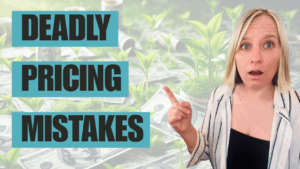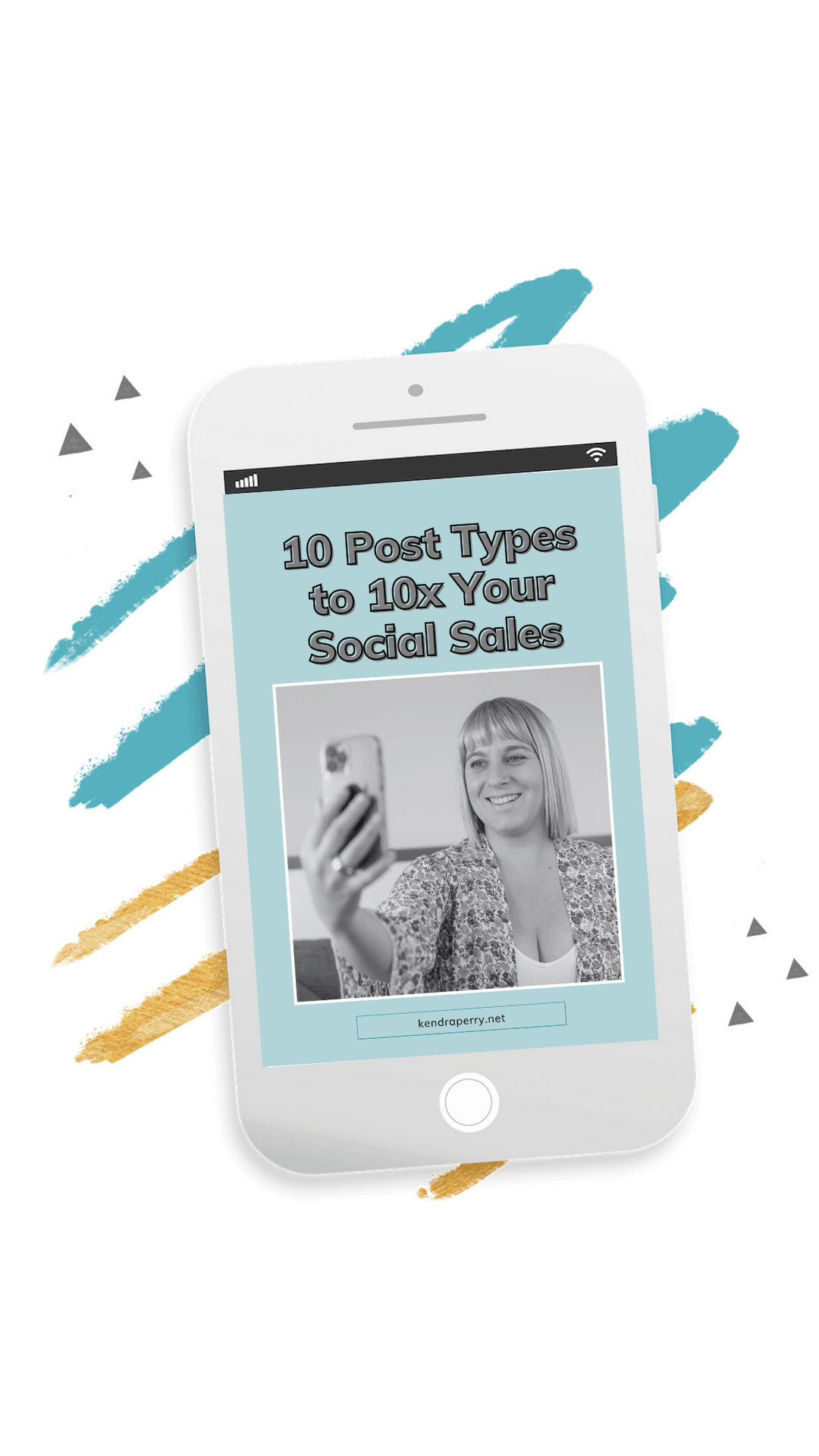With the rise in popularity of podcasting as a marketing tool, many businesses are considering launching their own podcasts. But with so many options and considerations to keep in mind, it can be overwhelming to know where to begin. In this episode, Kendra Perry discusses everything you need to know to get started in podcasting and if it’s the right choice for your business. She explains how podcasting is not just a trend but a powerful tool that allows businesses to connect with their audience on a deeper level. Kendra shares how to create a community around your brand and provide valuable content, which can build trust and loyalty that ultimately leads to business growth and success. Kendra also shares some great online tools to help you create and launch your podcast. Whether you’re considering starting a podcast or simply want to learn more about this powerful marketing tool, this episode should not be missed. Join us as we explore the world of podcasting and discover how it can help you grow your business and reach new heights of success.
Want to work with me inside Health Coach Accelerator? Start with our free training video: https://go.kendraperry.net/training
Give this podcast a 5-star review: https://RateThisPodcast.com/wealthy
Resources Mentioned: Blue Yeti | Camtasia | Upwork.com | Canva | Anchor.fm | Buzzsprout | Squarespace | Wix | WordPress | iMovie | Podetize.com | 360 Health Biz
—
Listen to the podcast here
Everything You Need To Get Started And Know If It’s Right For Your Biz
I’m always pumped and stoked to be infiltrating your brain cells. We’re going to talk about a topic that has been highly requested. I want to preface that I don’t teach this anywhere in my program but it is something that I know a lot about. I’m excited and happy to talk about it. We’re going to talk about podcasting, whether should you start a podcast, how to know if you’re ready to start a podcast and what goes into having a podcast because it’s a lot more work than you think.
I love podcasting. It is my favorite way to create content. I’ve always been a fan of longer-form content. I’ve gotten on the bandwagon with the short-form content, the short-form video and that sort of thing. It’s easier. It takes less time but I’ve always been a fan of long-form content, meaning having the time and the space to go a little bit deeper on a topic. I always love talking off the cuff. I struggle in produced videos. I do my YouTube videos and those are scripted. They’re great but it’s not me at my best. I feel like I’m at my best when I’m riffing. I have an outline that I’m following but I’m allowing myself to talk and go down a rabbit hole or a tangent if I want to.
That’s why I love podcasting. I love audio. I am a huge consumer of podcasts. I listen to podcasts constantly. I listen to business podcasts and health podcasts. This is a bit embarrassing. I listen to a whole lot of Bachelor recap podcasts. I love reality TV. I’ve always been a big fan of The Bachelor. I started watching The Bachelor in high school with Trista. If you’re a Bachelor fan, you know whom I’m talking about. She was the first Bachelorette. I’ve been watching it since then.
A few years ago, I discovered that some of the past contestants from The Bachelor had these recap podcasts where they would break down the episode and go into the psychology. Something I’ve learned is I’m obsessed with human behavior. That’s why I love marketing because it’s this experiment in human behavior and figuring out what gets people to respond. There’s something about it that I love. With The Bachelor and other reality TV, I love watching the dynamics. I love hearing someone who maybe has experience in psychology, counseling, human behavior dynamics and that sort of thing. I love hearing them break it down and look at it through a new lens.
A few years ago, I discovered these podcasts. I listen to these before I go to bed at night, which is funny. I have a bit of a busy mind. It helps me to put in a podcast because it distracts my brain and then I fall asleep super quickly. The thing I love about Bachelor recaps is it’s light. I’m not learning anything. It’s not scary. It’s not a true crime. It’s not intricate. It’s interesting but boring. It puts me to sleep.
I’m off on my rabbit hole. I love podcasts. I listen to it constantly. I love making podcasts. I also love consuming it. I’m not a huge consumer of video content. I don’t watch Instagram Reels. I’m not on TikTok. I don’t want to watch YouTube. I do love Netflix and reality TV. I love podcasting because it allows me to learn something on the go. It allows me to be entertained as I am skiing, on a walk or driving.
The cool thing about podcasting is it does help you reach a new audience that you may not be reaching through your social media. What I mean by that is there are podcast people. I consider myself a podcast person. If you want to connect with me, the best way to get to me is through a podcast because I’m not going to be watching your Instagram content or following your YouTube channel but I will listen to you on a podcast. For a very long time, I listened to long podcasts. I’m a huge fan of Joe Rogan. I listened to four-hour episodes. I listened to a four-and-a-half-hour episode from Andrew Huberman. I didn’t listen to it all in one go but I will commit to hanging out with someone for a very long time.
That’s an intimate experience. It’s intimate because if you think about Instagram content, it’s quick. People are consuming you in these little bite sizes but on a podcast, people could be hanging out with you for a long time. If you’re subscribed to this show and you listen to my episodes, you’re listening to me for anywhere from 15 minutes to 1 hour. What other context do I get your attention for that long?
It’s very cool in that way. It is a good way to reach a new audience. It’s a great way to create long-form content. It’s a great tool for repurposing. For example, all of my podcast episodes get repurposed into Pinterest pins. From the transcript, I have someone create a 1,000-word SEO-friendly blog post. Technically, I blog every week but I’m not doing any of the writing because it gets repurposed. I love repurposing content because we put a lot of effort into our content. If we’re going to make it, we might as well make it go a long way for us.
Something to keep in mind about podcasting is it’s decentralized. There’s not one place where people go to listen to podcasts. If you want YouTube videos, you go to YouTube. It’s not like that. If you subscribe to a podcast, you can listen on Apple, Spotify, Stitcher, Google Podcasts or a website. It’s decentralized and because of that, it doesn’t build an audience on its own. You can’t make a podcast, put it out there and expect people to find it. You have to put a lot of legwork into the promotion of it. You can promote on your social media, although I find that’s not the most effective way to market. You can run ads on it.
You can be a guest on other people’s podcasts, which as it turns out is probably one of the better ways to promote a podcast because when you’re a guest on someone else’s podcast, you are getting in front of the podcast people, the people who listen to podcasts. If they dig you and like your vibe, they’re going to subscribe to your podcast. The advantages are that you get in front of this new audience and create a more intimate experience. You have people listening to your content for longer, which is all very cool but the downside is you have to put a lot of work into promoting it. It’s not a platform on its own.
When would you say that you’re ready to start a podcast? You can start a podcast at any point in your business even if you’re just starting but because of all the work involved, which we’re going to talk about, you should only do a podcast if you want to do it, not because you think you should. It’s a lot of work. If you think you should, then you’re going to be one of those people who starts a podcast, makes it to seventeen episodes and gives up because it is a lot of work.
If you feel excited about podcasting and you think you’re going to love delivering content in that way, then go for it because I love it. It’s fun. I love to sit down, talk on the mic and get to go through these long episodes with you. It’s fun for me. You need to want to do it but if you’re in that category of people where you’re like, “I want to start a podcast. I’m up for the work. It’s super fun,” then this is what you’re going to need.
A Good Mic
First off, you’re going to need a good mic. The good news is you don’t have to pay a lot of money for a good mic. I use a Blue Yeti. There are lots of other options out there but my Blue Yeti probably cost me less than $150. It’s a pretty inexpensive mic. I’ve had it for over five years. It still works great. I love it. A Blue Yeti is a good one to use. You may or may not need a decent camera if you want to do video podcasting. I don’t do video podcasting. I used to but there’s something about videos that I find distracting. It was making me not like podcasting.
I stopped doing video podcasting and it’s just me on audio. I do the same with guests. We record on audio. I like it so much more rather than being distracted by the camera and looking at myself, “How do I look? Where do I look?” That whole thing happens to me. I can close my eyes and get into the topic. When I’m interviewing someone, I close my eyes and hear them. It helps them be a lot more present. I enjoy podcasting a lot more when I’m not on video.
Am I leaving a repurposing tool on the table? Yeah, because there’s a great repurposing opportunity here. I could be taking clips from my video podcast and putting them on Instagram Reels or YouTube Shorts. There are all kinds of things I could be doing and I’m not doing them. There is that. Maybe I’ll change my mind at some point but I’m enjoying doing podcasts on audio.
Recording Software
The next thing you’re going to need is recording software. You’re going to need a way to record. I use a program called Camtasia. I don’t recommend it. It is pretty expensive. I use it because I used to do all my editing for my YouTube videos in my course. It’s a bit more of a professional editing tool. I don’t recommend that. You can record on Zoom or even QuickTime. They’re fine. There are better audio experiences out there but we all know how to use Zoom at this point. You can record on Zoom. You turn your camera off if you want to do audio and download that recording to your computer.
You are going to have to edit it. We will talk about that. You’re going to need a podcast thumbnail. That’s the little square image that shows up in the feed for the podcast and is the main image for your podcast. I would recommend doing a professional photo shoot, getting some good photos of you and then hiring a graphic designer from an outsourcing platform. I like Upwork.com. That is my favorite. That’s the one that I use. It would be inexpensive for someone to do that. The other thing you could do is use Canva and make it yourself. I’m pretty sure they will have all kinds of templates you can use but you do want a good picture of yourself on the thumbnail.
Podcast Hosting
The next is podcast hosting. What that means is there’s a platform that hosts your podcast and then they distribute it out to all the various platforms because remember, podcasting is decentralized. There’s one host and then they’re going to submit it to iTunes, Spotify, Stitcher, iHeartRadio and Alexa. There are all these different podcasting apps and platforms but you want one host. I used to host on Anchor.fm. It’s free, which is great about it but I switched to Buzzsprout. Buzzsprout is what I’m going to currently recommend. It’s about $18 a month at the time of this recording.
The reason I use Buzzsprout is that you do get better analytics but this is cool. You get something called dynamic ad insertion. You can create your ads or if you get a sponsor for your podcast, you can do that as well. At the time of this recording, it’s the end of February 2023. Let’s say I want to promote an upcoming live event. Let’s say I have a webinar next week and I want to promote it on the podcast. If you’re listening to this podcast a year from now, my talking about that webinar from February 2023 is no longer going to be relevant anymore.
With dynamic ad insertion, you can create an ad. It will put it into every single one of your episodes. I believe they have pre-roll and end-roll, meaning they will put it in front of every episode and behind every episode. It’s cool because that means if you go back and listen to the first episode of this podcast, the ad that is advertising next week’s webinar will be there. I can delete it so that when that webinar is over, it will pull that ad out of the episode. How cool is that? I love this dynamic ad insertion.
That’s why I use Buzzsprout. You should always set yourself up for what you’re going to need because we did have to move from Anchor to Buzzsprout, which was overall a pretty easy process but it was a bit of a hassle. That’s why I recommend Buzzsprout because you get that dynamic ad insertion. That is so valuable because you’re promoting all kinds of things.

Let’s say you even get a sponsor for a podcast. Typically, when you get a sponsor, it’s not forever. You’re creating an ad for a sponsor for maybe 90 days or 4 weeks. What you can do is put it in so it goes even into the old episodes because, with podcasts, people go back and listen to your podcast from the start or at least scroll back a few months or even up to a year to see old episodes. How great is it that they are getting advertised as something relevant and timely? It’s very cool. That’s why I recommend Buzzsprout for hosting.
Website For Show Notes And Hosting Episodes
The next thing you’re going to need is a website for show notes and hosting episodes because podcasting is decentralized. You don’t get the best analytics but you can track analytics from people clicking on your website. I’m not a big fan of websites but I do think a website is necessary when you have a podcast. The good news is you can use any website-hosting tool. You can use Squarespace, Wix or WordPress. It only needs to be one page. It needs to list out your episodes and that’s it.

You will want to have show notes. You do want to want a place to list show notes. The other great thing about doing this is that if you’re repurposing your episode into a blog post, that can become searchable. That can optimize SEO. That can be a great way for people to find your podcast. You can also repurpose the episode into other things. I recommend getting it turned into a blog post because it’s a great way to repurpose. Should you do this yourself? No. We’re going to talk about that.
Editing Tool
The next thing you’re going to need is some editing tool because you’re going to make mistakes. You’re going to fuck up. You’re not going to want to start over. You’re also going to have to add your intro onto the front. We will talk about the intro in the next step here. The intro is the little thing with music that introduces people to your show. You’re going to have to put that at the beginning of your episode. There are a lot of easy editing tools. iMovie is easy. That one is free. I don’t know if you can get it on PCs but it works on Macs. What you’re going to have to do is you’re going to have to trim.
Here’s a quick tip that I can give you about editing. Every time I fuck up and make a mistake, I clap loud twice and then count to ten. When you’re looking at editing software, you will see the sound waves. What you will see is a big spike in the sound wave and then a blank. What that tells me is that I fucked up there and I have to go in and trim that. The good thing is when you’re editing audio, you’re just trimming. You’re not making anything crazily produced. That’s a pretty easy skill to develop. You can do it yourself but it’s a lot of work. Keep that in mind.
I have a producer. I use a company called Podetize.com. I love Podetize because they edit my episode, add on the intro and also turn that podcast episode into a blog post. They create all the social media promotional graphics for the podcast, upload them and schedule them. I love that. I use them. I pay somewhere around $100 to $120 an episode. I get a lot of good value for that but that is a bit of an investment of money. If you’re hiring someone to edit the show, then it’s not going to be as bad.
Create An Intro
The next is your intro. You want to create an intro for your show. The easiest way to do this is to record the intro. I recommend making it short. I even think mine at this point is a bit long. If you can keep it to 30 seconds or less, that’s great. Long intros are boring. You’re going to lose people that way. People want to get into it. What you can do is record yourself talking. You can hire someone on Upwork.com and get them to put some music behind it. What you’re looking for is royalty-free music. You cannot use any music. That would be a copyright issue. You could get yourself into some legal trouble.

What I did is I recorded myself saying the thing that I wanted to say, hired someone on Upwork and told them, “I’m looking for music that’s empowering and upbeat. I want it to make people feel fired up.” They gave me a few options. They took the audio that I sent them and put music behind it. They gave me a few options and I picked my favorite one. That’s how I got the intro for my show. It’s easy.
Podcast Graphics
Finally, you’re going to need podcast graphics to promote your podcast. It’s very easy to make templates. You can always have the same templates every time. You can create one of those audiograms where there’s a graphic and then audio playing in the back. Those are fine. Keep in mind that those aren’t great ways to promote your podcast. People are used to seeing those at this point. People on social media aren’t necessarily going to exit social media and go into your podcast but I still think it’s worth doing it. You could simply create templates on Canva, use the same template every time and update the episode name. You can do that as well.
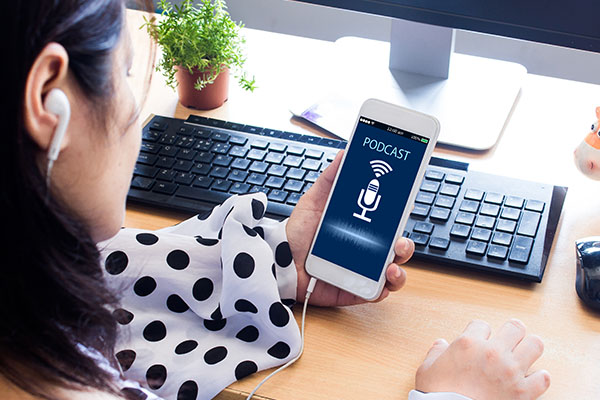
You’re going to need to schedule that out every week when your podcast goes out because, for a podcast to gain traction, you’re going to at least want to do one episode per week. That’s what I recommend. I batch my episodes. I’m recording three episodes all at once and then those get scheduled out. You can do that. That’s how I like to do things but I wouldn’t go more than once per week. You can go more than that. You can do 2 or 3 a week. That’s going to cost you a lot more money. It’s going to take a lot more of your time. Keep that in mind.
As you can see, there’s quite a lot that goes into producing a podcast episode. You have to record it, edit it, upload it to your hosting platform and schedule it. You need to add show notes, upload them to your website with the show notes and create promotional graphics for them. It’s a decent amount of work. I recommend having help with this. I probably wouldn’t do this on my own.
I had my first podcast called the 360 Health Biz podcast that I did with my friend Christine. In the beginning, I was doing all the work. I was doing all the editing and uploading. It was taking me about 2 to 3 hours for every episode. It was a lot. I was so exhausted that I had to get someone else to do it quickly because I couldn’t do it myself.
I don’t recommend doing this on your own for 2 to 3 hours per episode. If you’re dropping 1 episode every week, 4 times 2 is 8. 4 times 3 is 12. It’s a lot of work. The thing with podcasts is it’s a long game. It’s not something that’s going to get traction quickly. It’s something that builds over time. You don’t want to be putting all that work in for little return on investment.
It’s not getting you any traction in the beginning. I do recommend hiring someone to do it. You can probably get someone pretty inexpensive. You can create the graphics, the templates and the process. Someone can execute it pretty easily. Keep that in mind. Expect to spend about 2 to 3 hours per episode if you’re doing it yourself. That is a lot of work. I only recommend doing that once you can hire someone.
What about interviews? You will probably be asking, “Do I have to record all the episodes myself? What about interviews?” You can have a show that’s all interviews if that’s what you like to do. I typically do 2 to 3 solo episodes to 1 interview episode. Doing interviews can help you get more eyes on your podcast because you can have that person promote your podcast but that’s going to be more work because you’re going to have to find guests for your podcast. You’re going to have to schedule them and record with them. You’re going to have to send them an email with their promotional graphics and their swipe copy template for them to send to their list, plus social media.
That is an extra step as well. I’m a bit antisocial and introvert. I don’t like recording with people that much, which is why I probably do fewer interviews than the average person. I prefer to do these solo episodes because I can do them when I want. Here’s how I do things. I only record with guests twice a year and I record with them all in a week. I open up four days in my schedule in a week. Usually, two months in advance, we send an email out to all the people who have applied and we have approved or people whom I’ve told I want to record with. I do it all in four days and then we schedule them out over the next several months. That’s how I like to do things but you might like to do things differently.
That’s everything that goes into building a podcast. Let me know if you love this episode. Give it a little screenshot, add it to your Instagram Stories and tag me. Let me know what your biggest take-home is. If you’re thinking of starting a podcast, I would love to know. If you want to support this show and if you love the free information that you get from this show, I would so appreciate it if you could give me a five-star review on iTunes. To do that, go to RateThisPodcast.com/Wealthy. I hope you enjoyed this episode. I will see you at the same time in the same place where I help you become wealthy AF.

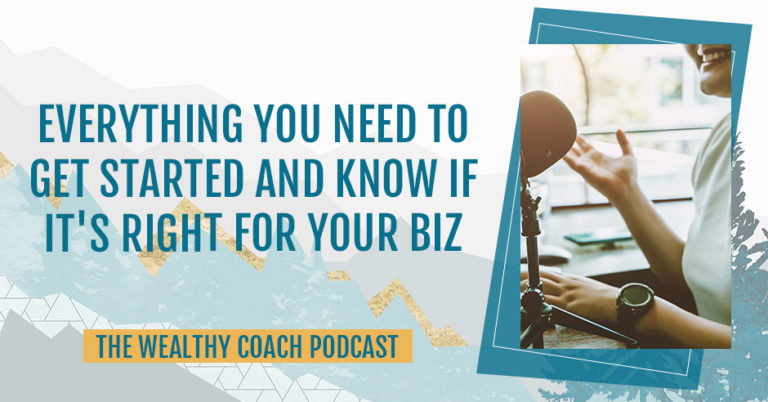
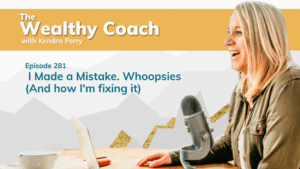
![[BEST OF] A Cautionary Tale About Your Niche](https://kendraperry.net/wp-content/uploads/2025/05/BEST-OF-A-Cautionary-Tale-About-Your-Niche-300x169.png)
